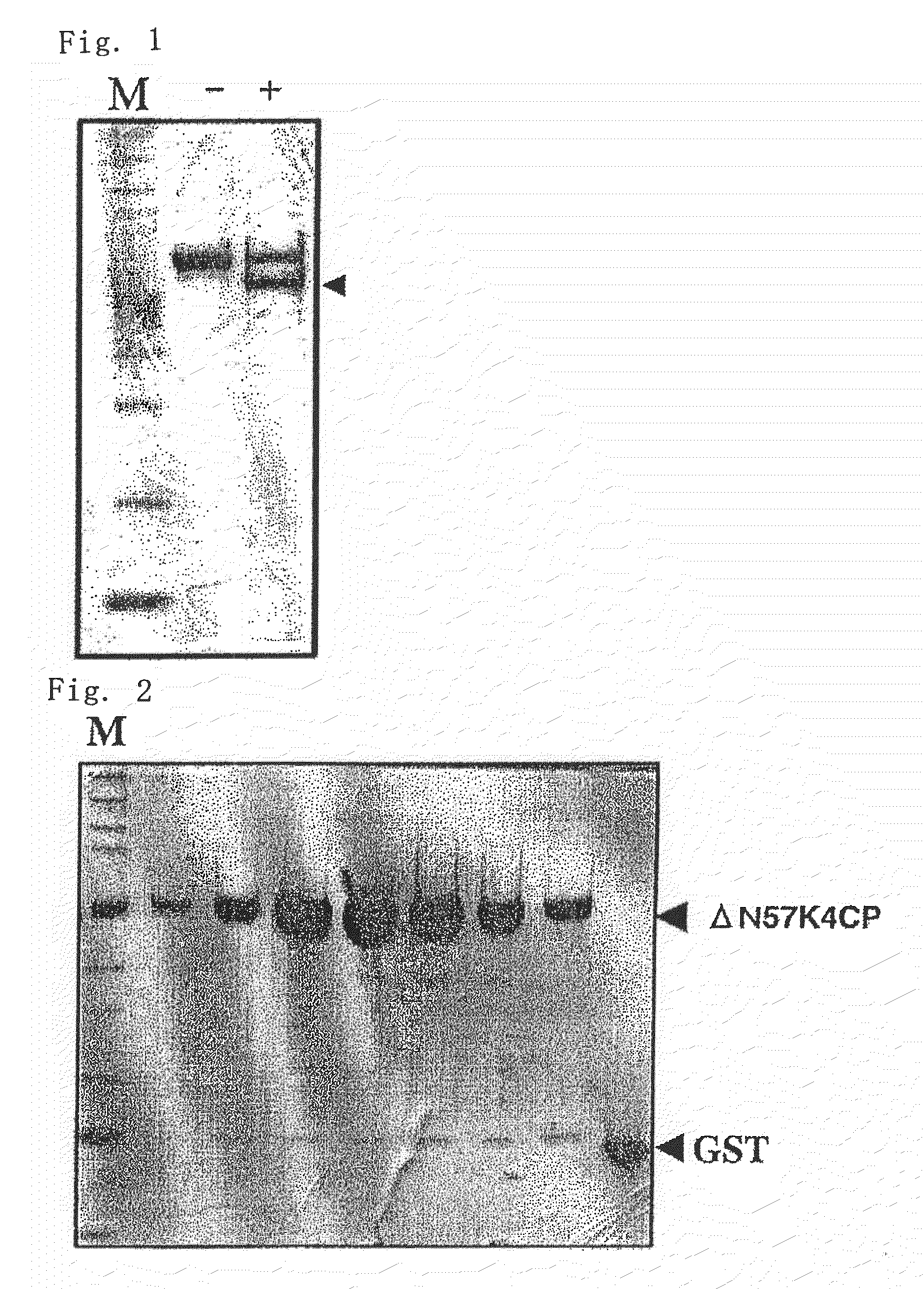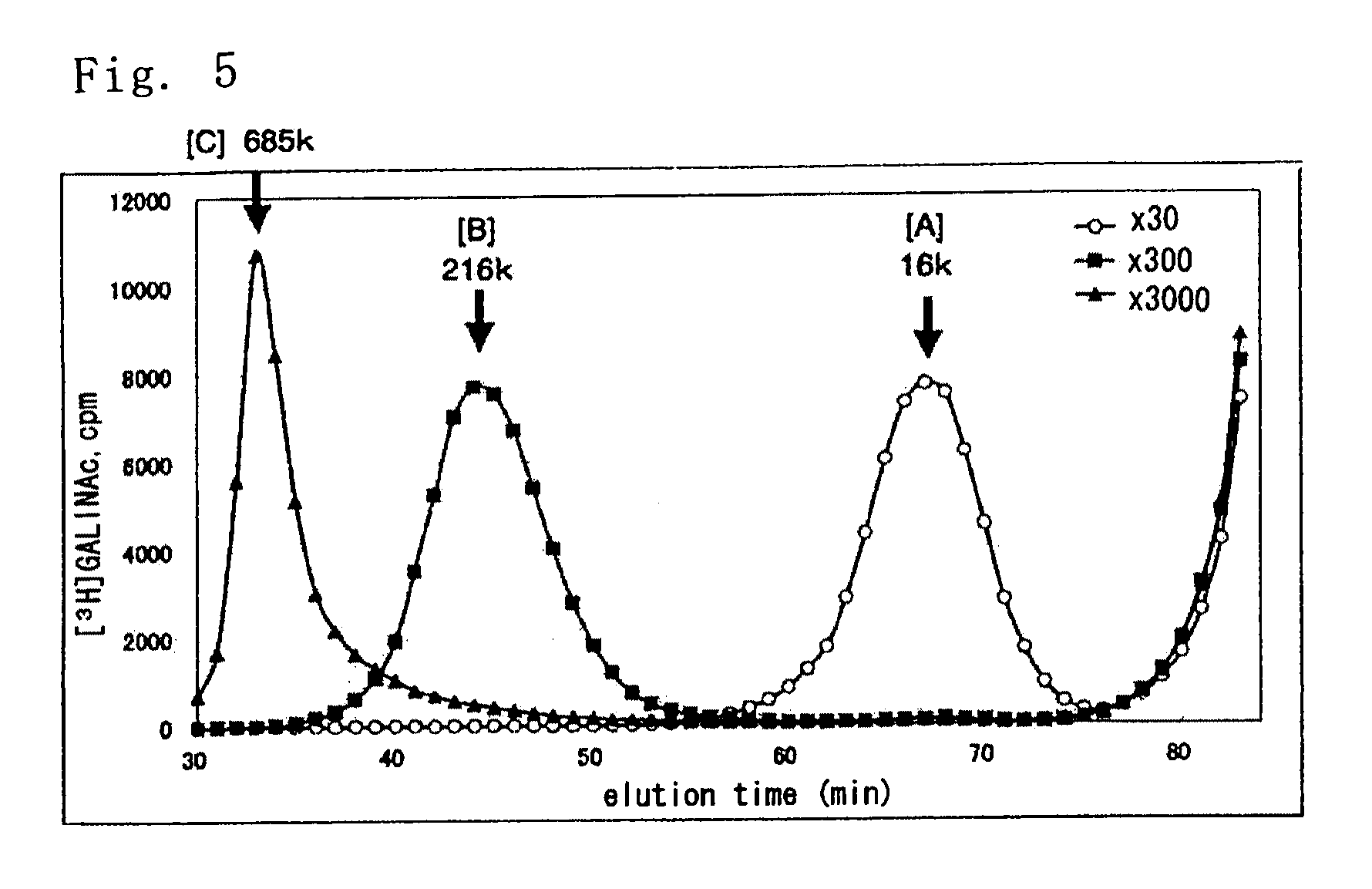Modified chondroitin synthase polypeptide and crystal thereof
- Summary
- Abstract
- Description
- Claims
- Application Information
AI Technical Summary
Benefits of technology
Problems solved by technology
Method used
Image
Examples
example 1
Production of Polypeptide of the Present Invention (ΔN57K4CP) by Trypsin Treatment of Wild-Type K4CP
[0132]A DNA having the nucleotide sequence of SEQ ID NO: 3 (encoding wild-type K4CP) was inserted between a BamHI site (nucleotide numbers 930 to 935 in SEQ ID NO: 5) and an EcoRI site (nucleotide numbers 938 to 943 in SEQ ID NO: 5) in pGEX4T3 (manufactured by Amersham Biosciences; the nucleotide sequence was shown in SEQ ID NO: 5) as an expression vector. The DNA having the nucleotide sequence of SEQ ID NO: 3 was prepared by the method described in Patent Document 1 (“insert” in Example 2 of Patent Document 1 corresponds to the DNA having the nucleotide sequence of SEQ ID NO: 3).
[0133]The DNA was used to transform Escherichia coli Top10F′ (Invitrogen), and the polypeptide was expressed in the same way as the method described in Example 2 of Patent Document 1.
[0134]The polypeptide expressed by pGEX4T3 was obtained as a fusion protein with GST (glutathione S-transferase), and the polyp...
example 2
Production of the Polypeptide of the Present Invention (ΔN57K4CP) by Genetic Engineering Technique
[0139]A DNA having the nucleotide sequence of SEQ ID NO: 1 (encoding ΔN57K4CP) was inserted between a BamHI site (nucleotide numbers 930 to 935 in SEQ ID NO: 5) and an EcoRI site (nucleotide numbers 938 to 943 in SEQ ID NO: 5) in the above-mentioned expression vector, pGEX4T3. The DNA having the nucleotide sequence of SEQ ID NO: 1 was prepared by PCR (polymerase chain reaction).
[0140]The DNA was introduced into Escherichia coli Top10F′ (Invitrogen), and the bacterium was cultured at 30° C. in 2×YT medium supplemented with ampicillin sodium at a final concentration of 100 μg / ml. When the concentration of the bacterial cells in the culture medium (OD600; absorbance at 600 nm) reached 0.6 to 1, IPTG (isopropyl-β-D(−)-thiogalactopyranoside) was added to the culture medium at a final concentration of 0.1 mM, followed by culture at 30° C. overnight. After completion of culture, a supernatant ...
example 3
Measurement of Enzymatic Activity
[0144]The chondroitin synthase activities of both ΔN57K4CP produced in Example 2 and K4CP produced by the method described in Example 2 of Patent Document 1 (obtained by fusing a peptide containing a His-tag with an N-terminal domain of the polypeptide having the amino acid sequence of SEQ ID NO: 4) were measured. The measurement method is as follows.
[0145]A reaction solution (50 μl) containing the polypeptide (2.0 μg) to be measured for its enzymatic activity, 50 mM Tris-HCl (pH 7.2), 20 mM MnCl2, 0.15 M NaCl, chondroitin hexasaccharide (0.1 nmol; Seikagaku Corporation), UDP-[3H]GalNAc (0.1 μCi, 3 nmol), and UDP-GlcUA (3 nmol) was incubated at 30° C. for 30 minutes. After incubation, the reaction solution was heated at 100° C. for one minute to terminate the enzymatic reaction. After that, the solution was applied to Superdex Peptide HR10 / 30 column (GE Healthcare Biosciences), and gel filtration chromatography was performed using 0.2 M NaCl as an el...
PUM
| Property | Measurement | Unit |
|---|---|---|
| Lattice constant | aaaaa | aaaaa |
Abstract
Description
Claims
Application Information
 Login to View More
Login to View More - R&D
- Intellectual Property
- Life Sciences
- Materials
- Tech Scout
- Unparalleled Data Quality
- Higher Quality Content
- 60% Fewer Hallucinations
Browse by: Latest US Patents, China's latest patents, Technical Efficacy Thesaurus, Application Domain, Technology Topic, Popular Technical Reports.
© 2025 PatSnap. All rights reserved.Legal|Privacy policy|Modern Slavery Act Transparency Statement|Sitemap|About US| Contact US: help@patsnap.com



